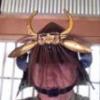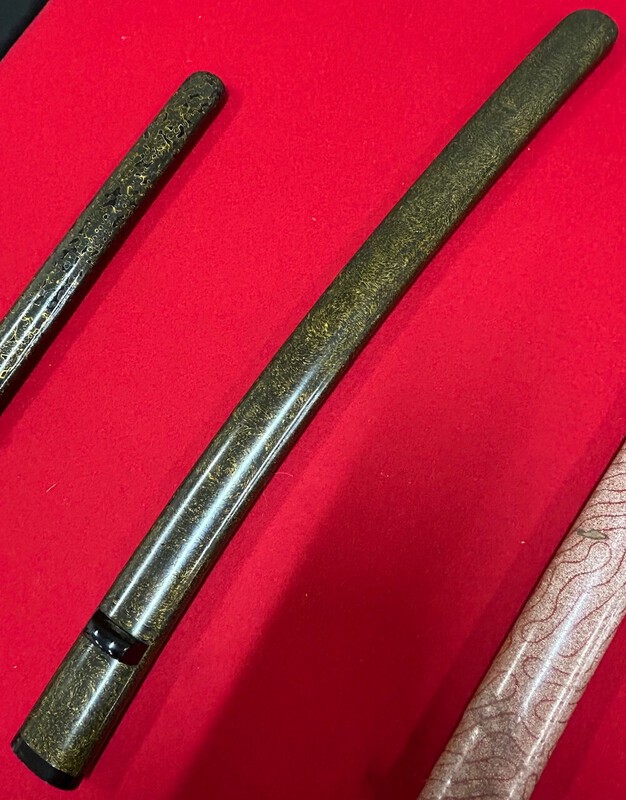-
Posts
13,068 -
Joined
-
Last visited
-
Days Won
222
Content Type
Profiles
Forums
Events
Store
Downloads
Gallery
Everything posted by Bugyotsuji
-
Apologies, for the deleted post. I see now that the only date given is for the cutting test, not for the blade's manufacture. (You will have to look up Kanefusa and decide if it is Muromachi, which is not mentioned in the attribution.)
-
Since we can only see part of the problem I would do nothing for the time being. You often see saya out in the marketplace that are temporarily bound with string, elastic, etc., so I would be tempted to do a temporary fix (making sure nothing is touching or rubbing as Grev says), while following Lewis's advice to find a Togi- or Saya-Shi.
-

Japanese sword maker translation
Bugyotsuji replied to AirborneA152's topic in Translation Assistance
o is the correct pronunciation, BaZZa, but to me it looks strange in context, in English, so I tend to use the old Romanization 'wo' of を which is part of the 'wa (wi wu we) wo' line of the traditional Japanese alphabet. You are right to point this out and I need to sit back and ponder... -
Great work, Simon, looking a lot better already. Everyone was giving you like signs, but waiting to see who would enlighten us first!
-

Japanese sword maker translation
Bugyotsuji replied to AirborneA152's topic in Translation Assistance
Kiipu's link goes deeply into this and is a good read. There is of course a difference between the 'correct' way to write it, and the 'correct' way for us to read it. The simple answer is that both tsukuru kore and kore (o, or wo) tsukuru are 'correct' in the sense that they are minimal readings of the inscription from which any Japanese would get enough meaning to understand. Listening Japanese would nod in understanding, even without a past tense. Kore wo tsukutta or kore wo tsukurimashita would actually be more grammatically fluent and correct, but would go beyond what is inscribed there. Think in English for a minute. John make this, or John this make. Both convey simple meaning. But if you want to fully 'translate' them, you would adjust into the past tense and say, This was made by John, or John made this. In other words, both Tom and Uwe are correct for a Japanese audience, or someone educated sufficiently in Japanese sword language. Remember, these are classical Chinese characters written with no Japanese endings on them, so we are left to guess how they relate to each other. Thus, personally speaking, I do not think it matters much how we render the ending of such a signature; there is certainly no need to worry unduly about manners or correctness. PS Your blade actually says 造之 'Tsukuru kore', reading the characters as they are. Kore wo tsukuru is a slight nod, or further step towards correct grammar, but is an interpretation, along the path of how to render classical Chinese into readable Japanese... -
It may be a treasure map tsuba that the previous owner put back together…
-

Weird old altered Heianjo Tsuba into iron shinai tsuba?
Bugyotsuji replied to Kantaro's topic in Tosogu
More likely ichō 銀杏, gin-nan, ginkgo leaves design, no? -
心哉 can also be read Shinya. https://namedic.jp/names/name/心哉
-
A single fuzzy photo of a rusted Kanji sets the scene, but Netsuke artists used the 哉 Kanji with the ‘sai’ reading, so I checked a couple of name lists and nothing came up, but… This could be an artist known in other fields so may be worth cross-checking similarly.
-
I get what you are saying but we can see Hanabishi for example in both areas. Actually my own sense is that the artisan chose some brass Mon (rimmed) disks almost at random, for the pattern rather than any affiliation.
-
Hi Jake, Here is a Kamon map of southwestern Japan and Kyūshū. I am sure you have consulted such maps already, but please compare this with the area of Kansai and east which follows this post. Kyūshū
-
People often mistakenly compare it with Arlington, as in the post-WW2 letter above, and although of a similar spirit, true, there are no actual bodies or remains interred at Yasukuni Jinja, purely lists of names. Magnificent set, congratulations. Some years ago a friend called me and asked if I could drive his car for him. A strange request indeed. Following his instructions I drove to the riverside. “Watch this!” he said as he pulled out a Nambu, (totally illegal here) and without further ado threw it far out into the river.
-
14 years... JUMP
-

Latest tsuba for a translation query
Bugyotsuji replied to kissakai's topic in Translation Assistance
Correct all that old information now while Nobody San's post is till fresh! -

Single character on brass lock plate
Bugyotsuji replied to Bugyotsuji's topic in Translation Assistance
As an adjunct to this, there is a kamon on the barrel, but since these were often added later I cannot put too much weight on it. The shape is a 蛇の目 Janome, or snake's eye, said to be talismanic; originally this mon depicted the 弦巻 tsurumaki spare cord reel for a bow which hung at the left side by the tachi koshirae. The most famous user of this mon was Kato Kiyomasa, but since he once called Inatomi Ichimu a traitor, I cannot imagine him placing his mon on an Inatomi Ryu gun. There were several families in mid Japan who used the janome, (Kato, Toda, Hori, Ishikawa, Kutsuki, etc.) but all seem to have kept it as their kaemon, i.e. secondary. There was another famous Mitsuyasu branch of the Kato who served under Hideyoshi in Owari and later from 1629 ruled as lords of Ozu Castle in Shikoku. This family used the janome mon as their main 本紋 'Honmon' or 正紋 'Seimon', and kept it throughout Edo, not as a substitute or secondary 'Kaemon', according to a geographical map of Kamon. So if we had to tie all this information together, it could be the material for a small paper! An Inatomi school gun that served the Mitsuyasu branch of the Kato family, possibly made in Owari province in the early to mid-Edo Period. A likely story! Thank you everyone who had a look, showed interest or even participated in this thread! Much appreciated. -

Single character on brass lock plate
Bugyotsuji replied to Bugyotsuji's topic in Translation Assistance
Thanks for that vote, Steve! The scales are now tipping more towards one of those listed 古田 Furuta lockwork makers above, (other readings such as Koden are possible), meaning the gun itself could well have been produced in Owari around mid-Edo, c.1680-1780 ish. “Grrrrrreattttttt!!!” says Tony the Tiger! -
Many Daimyo around Japan used the nine-star Kuyomon, including Date Masamune, but possibly the Hosokawa were the most famous. As to Yamagane, I heard just recently that it is copper extracted 'as is' from a mine, meaning that it includes trace impurities, i.e. it is inconsistent throughout Japan. Suaka by contrast is literally 'pure copper' that has had the impurities removed.
-

Single character on brass lock plate
Bugyotsuji replied to Bugyotsuji's topic in Translation Assistance
(Please excuse the update, but after some research I wish to record my thoughts here while they are still in my mind.) Problem restated Can we read it, and then find a place of manufacture based solely upon this unreadable lockplate character or mark? The school of gunnery is Inatomi Ryu, (also pronounced Inadome) but the gun is unsigned. Guns were made to Inatomi specifications in Kunitomo, Sakai and Owari at least. Checking the matchlock mechanism artisans, there were no likely candidates in Kunitomo, Sakai or Sunpu, but in Owari there were three generations of Furuta with names beginning with Ichi 市, i.e. Furuta Ichirobei (Genroku), Furuta Ichirozaemon (Kyoho) and Furuta Ichizaemon (Tenmei). Ichimu's following generations served in Owari. Gun locksmiths did indeed sometimes sign with a stamp or impression using one character of their name, often the first letter of the individual name, so, one possibility, i.e. that this is Ichi 市, is born, or to some extent borne out here. The famous Inatomi Ichimu 1551-1611 was the eldest son (or grandson?) of Inatomi 祐英 (Sukehide) and was originally named Yojiro, then Sakon, then Iga no Kami Minamoto Sukenao 祐直. His skills in gunnery were noted by many Daimyo who wished to have him teaching close at hand, such as Tokugawa Ieyasu at Sunpu. Notably, the famous swordsmith and gunsmith Hankei (Nihon Kiyotaka) also worked there and produced guns in the Inatomi/Inadome school style. Notice here the Kanji character in the thread's opening post above once more, that no one except Uwe has commented on. Uwe agreed with ネ at first, then possibly 市. But! What if? What if the character stamped on the lockplate above is a construct, an amalgam/amalgamation of the common-to-both character 'Suke' 祐 (ネ and 右) of the father 祐秀Sukehide and the famous (grand) son 祐直 Sukenao, later 'Ichimu'? This could account for the appearance of ネ with a 口 lower right. Hmmm... Or to take this a step further, might the locksmiths have blended their character Ichi 市 with the Suke 祐 of the founders Sukehide and Sukenao? Enough of the brain storming. Here is some background concerning the school of Inatomi/Inadome Ichimu, in English. https://www.japanesewiki.com/person/Sukenao INADOME.html -

Edo Period Corner Part II
Bugyotsuji replied to estcrh's topic in General Nihonto Related Discussion
Point of interest. Asking about the tanto shirasaya and tsunagi, I got a message back saying it should be ready shortly. As to togi though, we face a fine problem. The primary dilemma for the togishi will be how to preserve this blade's sugata throughout any polishing process undertaken. Change the silhouette or geometry, and you could soon have a new kitchen knife. My guess is that previous owner(s) have already agonized on how to best preserve this blade. -
I was thinking yamagane too.
-
You could do both, an internal double-ended screw, plus an outer metal sheath to keep it all straight, then bind with fine cord, and place another similar cord bound section at an equal but opposite location giving it a more balanced look... (?)
-
Such a shame that they have to do this. Sad old world where the laws make life difficult and uncomfortable for everyone, and culture gets abused in the process. What you've done looks like a pretty good fix, you are happy, and you still have the ability to dismantle and travel! (Besides, if you find a better method in the future, that option is till open.)
-
Jiro (but no Taro) Naokatsu. Unless I am missing something, Nobuie is on the front of the tsuba, and the humble artist Jiro who emulated Nobuie has placed himself on the reverse, no?
-
A wire hanger may be too strong, difficult to bend to the right shape, and possibly damaging to the saya. If you do not have the equipment for Brian's approach, Natthaniel's wire idea may be better. Source a section of the right thickness, and play with different shapes of hook. The thing is to do it in your head first, over a day or two, and wait for the answer to crystallize in your brain. You have to work intuitively.












